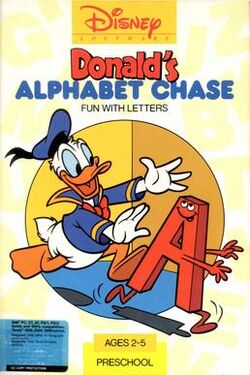Software:Donald's Alphabet Chase
| Donald's Alphabet Chase | |
|---|---|
 DOS Cover art | |
| Developer(s) | Westwood Associates |
| Publisher(s) | Walt Disney Computer Software |
| Producer(s) | Darlene Waddington |
| Designer(s) | Darlene Waddington, Brett Sperry |
| Artist(s) | Paul Johnson, Maurine Starkey |
| Composer(s) | Mike Clarke, Dave Kelly |
| Platform(s) | Apple II, Commodore 64, Amiga, Amstrad CPC, DOS, ZX Spectrum |
| Release | 1988 1990 (C64)[1] 1991 (Amstrad CPC, ZX Spectrum) |
| Genre(s) | Educational |
| Mode(s) | Single-player |
Donald's Alphabet Chase is a 1988 educational video game developed by Westwood Associates and published by Walt Disney Computer Software. It was released on various home computers including the Amiga, Amstrad CPC, Apple II, Commodore 64, DOS and ZX Spectrum. An Atari ST version was planned by Nathan Software but got no release.[2] The game was released in five different languages including English, Spanish, French, Italian and German.
Plot
The Alphabet pets have escaped from the toybox in Huey, Dewey, and Louie's bedroom and are roaming around Donald's house. It is up to Donald to catch them and bring them all together.[3]
Gameplay
The player helps Donald to catch runaway letters. The gameplay is pretty straightforward. In each room of his house, Donald will chase three, four or five letters. The player is required to press a letter on the keyboard which corresponds to the letter that Donald is trying to catch.
Educational goals
The game was designed on a low budget[4] with the ability to teach literacy at a basic level, letter recognition and simple keyboard typing skills as well as reinforcing knowledge on uppercase letters[5] and thus teaching them how to match letters of the alphabet with the letters on the keyboard.[6] The structure of the letters divided into five rooms allows children to understand and learns different letter groups.[7] Children can freely explore the game, while parents can guide them depending on their abilities.[8]
Reception
Critical reception
| Reception | ||||||||
|---|---|---|---|---|---|---|---|---|
| ||||||||
A Computist reviewer gave the Apple II version 3 out of 5 stars, praising the game's animation and decent sound, but deeming it lacking in challenge.[9] Amiga Format gave the Amiga version 4 out of 5 stars, finding the animations hilarious to watch, but finding the use of uppercase letter limiting in teaching material.[10]
Commercial performance
The game along with Mickey's Runaway Zoo and Goofy's Railway Express sold around 400,000 copies in a year of their development.[11] The Amiga version was showcased at the 1990 Summer Consumer Electronics Show.[6] By April 1991, the Amiga version became one of the top 10 selling products in the UK.[12] By October 1991, the game was showcased at the annual Windhoek Show as part of Schoemans Office Systems.[13] Of the 25 computer Disney Software games around 1993, "Donald's Alphabet" chase was among the most successful.[14]
See also
- List of Disney video games
References
- ↑ http://ready64.org/giochi/manuali/donalds_alphabet_chase/dolnald_alphabet_chase_floppy_disk.jpg [bare URL image file]
- ↑ Davison, John S. (August 1991). "ST File - Disney Software". New Atari User (Page 6 Publishing) (51): 51, 56. http://publicaciones.retromuseo.com:8123/Revistasv1/Page%206/page%206%20051.pdf.
- ↑ Trivette, Don (September 24, 1991). "Early Learning Software". PC Magazine 10 (16): 496. https://books.google.com/books?id=6UNWdidjDmIC&pg=PP530.
- ↑ http://svn.dridan.com/sandpit/QA/trecdata/datacollection/sjm/sjm_017 [bare URL plain text file]
- ↑ Jones, David (September 1991). "Can you count on Disney time?". ST Format (Future plc) (26): 124, 126, 128. http://www.atarimania.com/mags/pdf/atari-st-format-issue-026.pdf.
- ↑ 6.0 6.1 Bjornsen, Harold R. (October 1990). "Disney on Disk". Run (IDG Communications) (80): 10. https://www.commodore.ca/wp-content/uploads/2016/01/run_issue_80_1990_oct-www.commodore.ca.pdf.
- ↑ "Learning with Mickey". Crash (Newsfield Publications) (85): 29. February 1991. https://archive.org/details/crash-magazine-85/page/n29.
- ↑ "Circle Reader Service Number 342". Compute! (ABC Publishing) (85): G16–G17. May 1992. https://archive.org/details/1992-05-compute-magazine/page/n113.
- ↑ 9.0 9.1 "The Product Monitor". Computist (SoftKey Publishing) (78): 6. 1990. https://archive.org/details/computist-scan-78/page/n5.
- ↑ 10.0 10.1 Winstanley, Pat (May 1991). "Down with Skool". Amiga Format (Future Publishing) (22): 120. https://archive.org/details/amigaformat22/page/n119.
- ↑ "Westwood Studios Profile". http://www.tsden.com/articles_wwhistory.htm.
- ↑ "The April Charts from Centresoft". Zzap!64 (Newsfield) (72): 7. April 1991. https://archive.org/stream/zzap64-magazine-072/ZZap_64_Issue_072_1991_Apr#page/n5.
- ↑ "Disney Software for Home Computers" (in en-US). The Namibian. October 8, 1991. https://www.namibian.com.na/archive_pdf_19851990/1991_TheNamibian/8%20October%201991.pdf.
- ↑ Apodaca, Patrice (May 25, 1993). "World Is Small So Far for Disney Software" (in en-US). LA Times. https://www.latimes.com/archives/la-xpm-1993-05-25-fi-39510-story.html.
External links
 |

